Population of Interest
- The African Americans in Brookland Ward 5 comprise of 15 percent of the total population.
- The actual population of the blacks is 62,864 (Whiteshield Center, 2015).
- The females are 50.2% while the males are 49.8% of the population. On age distribution, persons below 6 years represent 6.8%, 6-19 years represent 14.5%, 20-64 years represent 69.6%, and those above 64% represent 9.1% of the total population (Whiteshield Center, 2015).
- The average family size of this population is 3.5 (Whiteshield Center, 2015).
- The average life span of the population stands at 48 years (Whiteshield Center, 2015).
- This community is characterized by a constant population growth rate of 4% (Whiteshield Center, 2015).
- At present, almost the entire population is literate and this is projected to hit the 100% mark in the near future (Whiteshield Center, 2015).
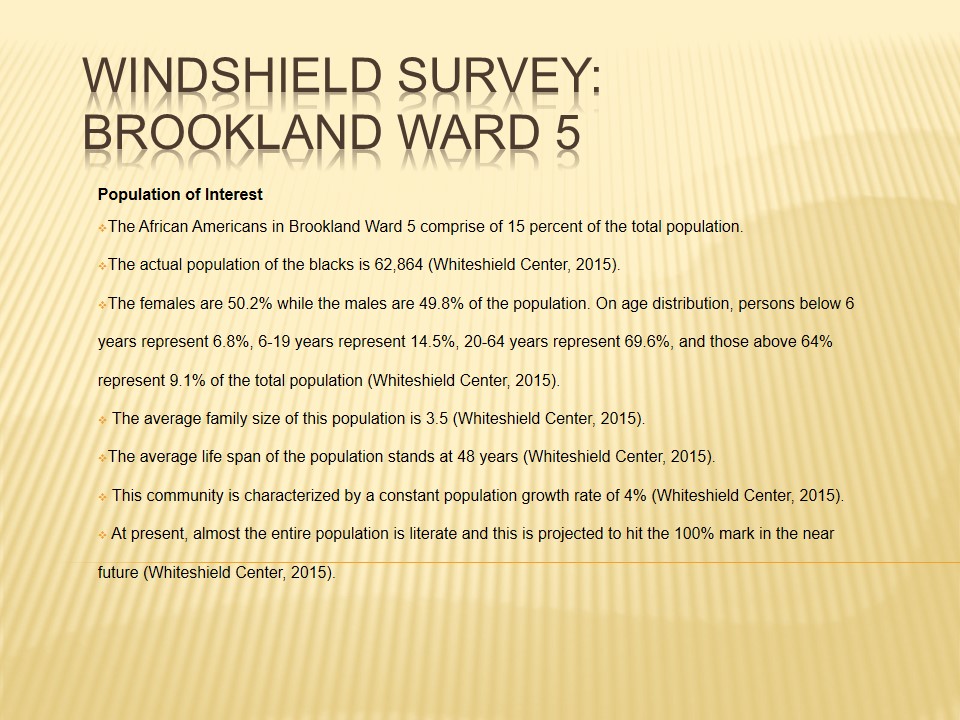
Actual Housing Conditions
- 20% of the houses are not of acceptable quality.
- Most of the houses are more than three decades old.
- Majority of the houses are for multifamily dwelling with a few being single units as attached in these pictures.
- Most of the dilapidated houses are in a condition that can be repaired or restored.
- Due to high housing demand, it is very difficult to find a vacant house.
- The poor housing can be attributed to population explosion against low income and high unemployment rate (Special Collection Center, 2016).
- These aspects are discussed in the next sections of the presentation.
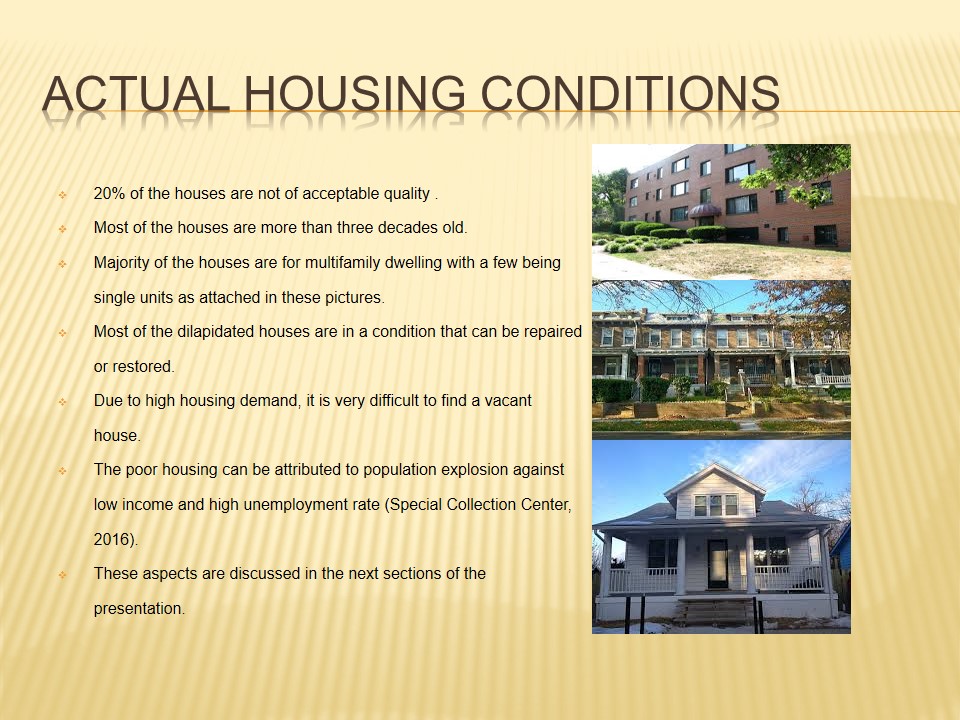
Role of the population in the Community
- The most common mode of interaction within this community is through informal communication, politics, trade, and cultural events.
- These events attract members of this community.
- They have voting blocks, family ties, and community programs on chronic diseases, family planning, economic linearization, and freedom when experts are consulted (Special Collection Center, 2016).
- The community network comprises of the formally and informally educated persons who fall into different social classes within the population.
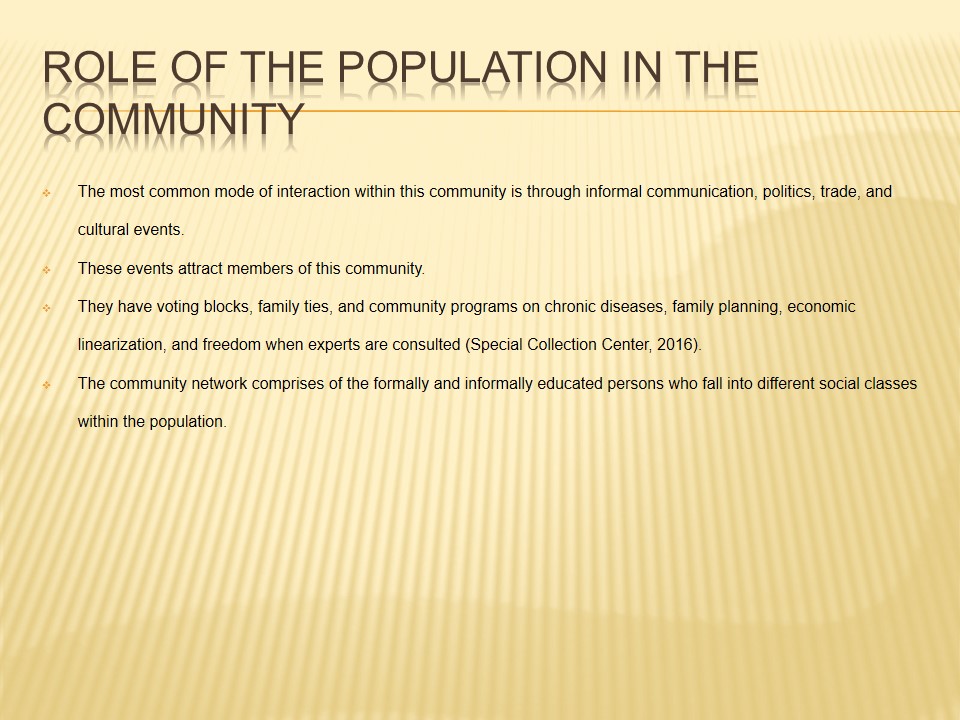
Boundaries of the Group
- The Black American community within Brookland Ward 5 is spread evenly within Whitefield.
- Brookland Ward 5 boasts of extensive settlement with each cultural group occupying different estates (Special Collection Center, 2016).
- Specifically, this community occupies Brookland Ward 5 region.
- The population density of Brooklyn is 34, 920 per square mile (Whiteshield Center, 2015).
- The average house unit density is 13,180 per square mile (Whiteshield Center, 2015).
- There are 34,000 households occupied by the African American within this region (Whiteshield Center, 2015).
- The average size of each household size is 2.8 (Whiteshield Center, 2015).
- The main safety hazards in Brookland Ward 5 community are contamination as a result of poor solid and liquid waste management and limited housing.
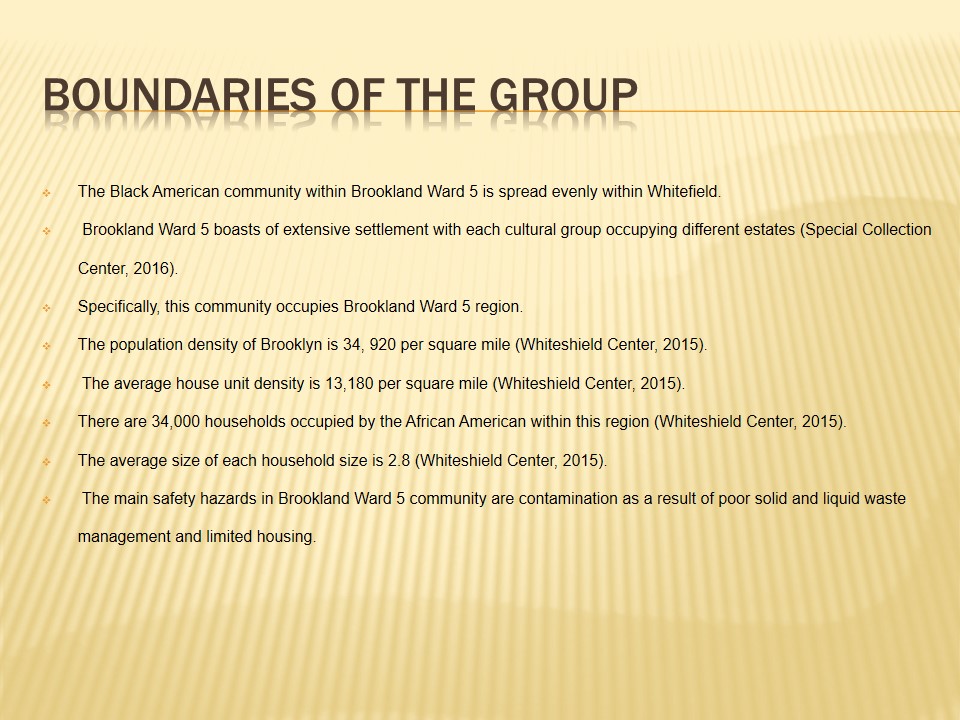
Income and economic standing
- From the research survey, the community faces challenge of adequate housing.
- Due to poverty level of 20%, the average income is at $3000 per month (Whiteshield Center, 2015).
- The household income is $32,135 while median income per family is $36,188. Per capita income is $16,775 (Special Collection Center, 2016).
- On an average, the community literacy level is 80% (Whiteshield Center, 2015).
- Besides, those with collage education account for 35% of the population (Whiteshield Center, 2015).
- The employment rate stands at 69 percent (Whiteshield Center, 2015).
- Those informal sector accounts for 49 percent while those in private sector accounting for 51% (Whiteshield Center, 2015).
- The major employers are the government, local authorities, and private businesses.

Nursing Diagnosis
Objectives
- To establish the housing challenges in the Brookland Ward 5 region.
- To recommend the healthcare support to the affected population.
- To recommend financial and social support to those in need of housing.
Goals
- To assess the actual level of housing disparity.
- To assess how the disparity affect healthcare concerns.
- To offer recommendations to address the concerns.
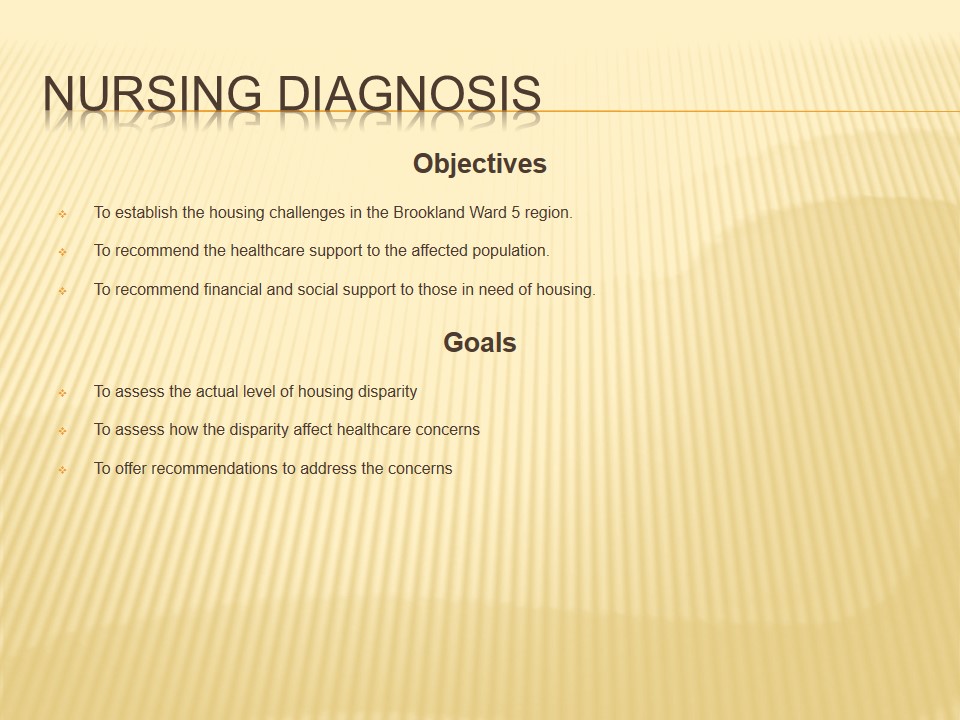
Health concerns as a result of poor housing
- Due to low income, the consumption patterns of this community align with basic needs.
- Despite this, the majority of this population is aware of healthy dietary and are at the forefront of promoting healthy eating habits.
- The alcoholic consumption rate stands at 12% with drug abuse more prevalent among the young adults who are the majority who cannot afford better housing (Special Collection Center, 2016).
- The main health hazards posed by these activities include injury and infection.
- The main health education services offered in this community include family planning, health living and eating habits, and preventive care.
- However, there is need to assist the vulnerable members of the community through integrating community based case as part of addressing the healthy people 2020 initiative.
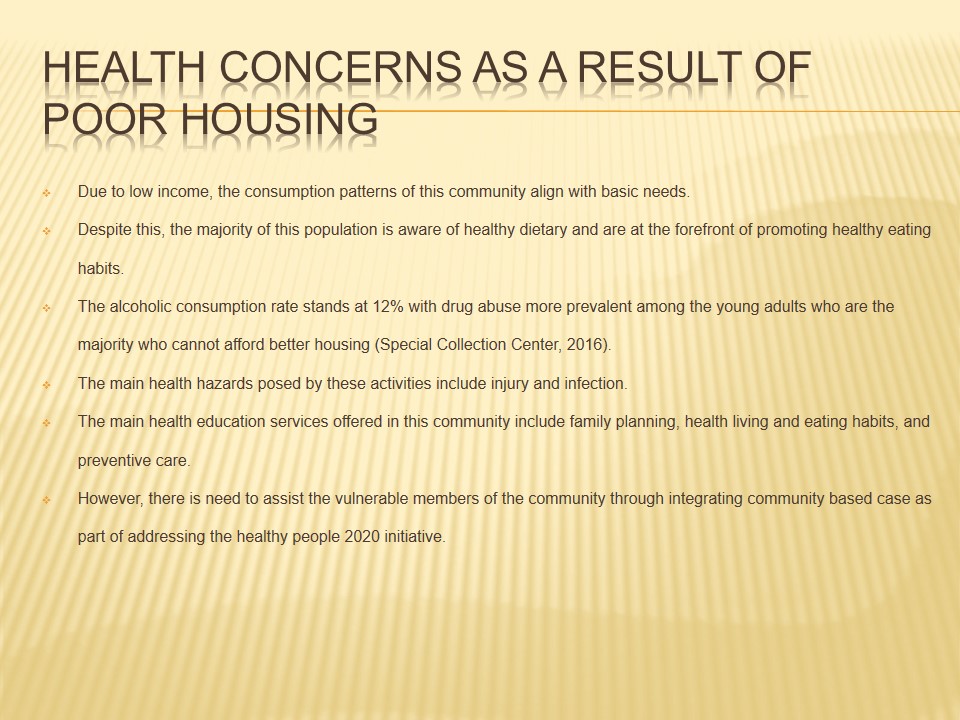
Healthy People 2020 Leading Health Indicator (LHI)
- Access to health care service is one of the main indicators of the Healthy People 2020.
- This indicator shows the standards, reliability, and availability of health services in a community, especially among the vulnerable persons (Healthy People 2020, 2016).
- In this case, the vulnerable people are those who cannot afford better housing.
- Access to health care service improvement will ensure that families in this category are served with affordable, accessibly, and flexible health care Healthy People 2020, 2016).
- This indicator will address the present concerns and create room for modifications to counter any future dynamics in health status of the target community.
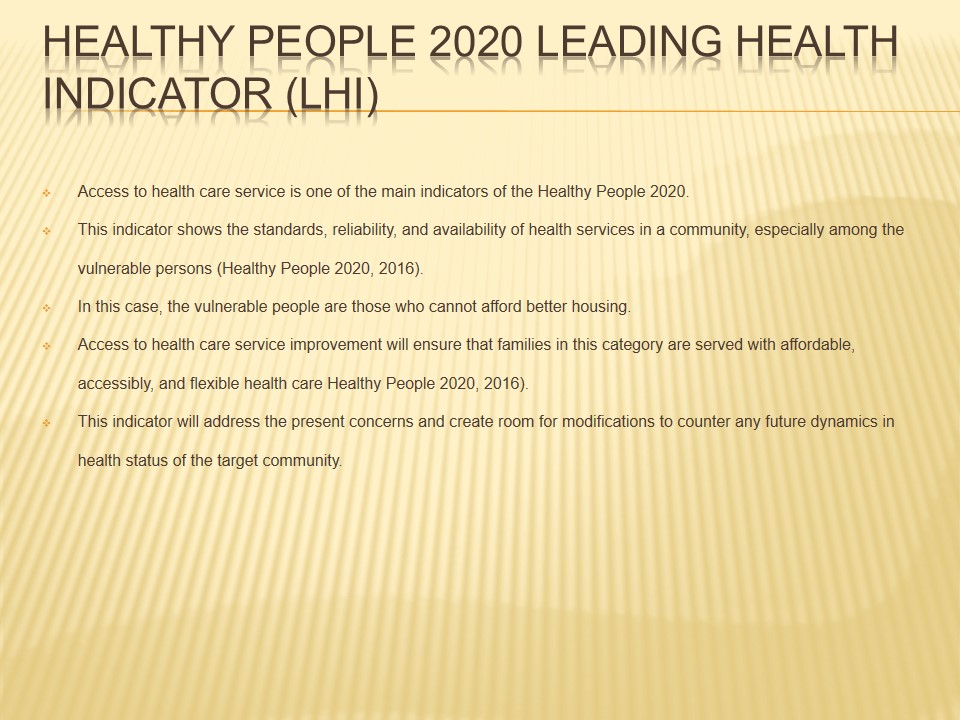
References
Healthy People 2020. (2016). Healthy People 2020 standards. Web.
Special Collection Center. (2016). Guide to the Brookland neighborhood. Web.
Whiteshield Center. (2015). Quick Facts from the US Census Bureau. Web.